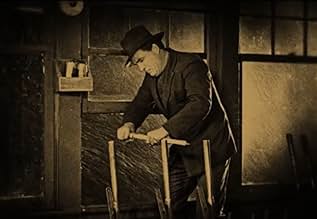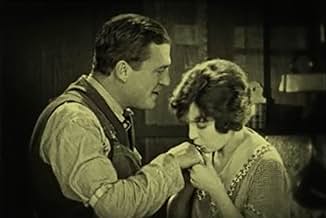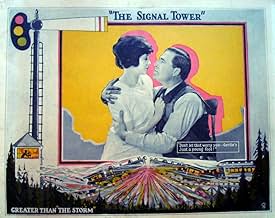Ajouter une intrigue dans votre langueA railroad worker accepts a colleague's offer to stay in his home, but when his friend is called out one night to stop a runaway train, he makes a play for the man's wife.A railroad worker accepts a colleague's offer to stay in his home, but when his friend is called out one night to stop a runaway train, he makes a play for the man's wife.A railroad worker accepts a colleague's offer to stay in his home, but when his friend is called out one night to stop a runaway train, he makes a play for the man's wife.
- Réalisation
- Scénario
- Casting principal
- Récompenses
- 2 victoires au total
Avis à la une
Rockcliffe Fellowes is the tower man on a mountain pass. He lives a few hundred yards away with his wife, Virginia Valli, and their son, Frankie Darro. When Wallace Beery comes in as shift manager, he stays with them... until Miss Valli grows worried about the innuendos he keeps making. It all comes to a head one stormy evening, when Beery is liquored up and Fellowes is trying to deal with a runaway train.
Clarence Brown's movie looks like pretty much a standard programmer for a Universal film, but it has some nice touches to it, including a working knowledge of how switch towers actually work, and a pretty good arc from idyllic to thrilling. The cast is eked out with roles for Dot Farley and J. Farrell MacDonald. It's another competent production from Universal that still plays pretty well.
Clarence Brown's movie looks like pretty much a standard programmer for a Universal film, but it has some nice touches to it, including a working knowledge of how switch towers actually work, and a pretty good arc from idyllic to thrilling. The cast is eked out with roles for Dot Farley and J. Farrell MacDonald. It's another competent production from Universal that still plays pretty well.
While not all silent films are equal, just because a film isn't absolutely outstanding doesn't mean it can't still be reasonably enjoyable. 'The signal tower' tells the type of story that sometimes lets viewers predict the course of events 2-3 steps ahead or more with each beat that's laid out before us. Some older movies are more overt than others when it comes to expression of antiquated social norms and values, and at least in part this is surely one of them; some pictures of the silent era come off as more staged and contrived than natural and nuanced, and this perhaps falls somewhere in the middle. Suffice to say that this is perhaps not wholly essential, and anyone who isn't already enamored of the timeframe might not find anything here to change their minds. Still, it's suitably entertaining on its own merits, and a decent way to spend 80 minutes.
In fairness, this feature adopts a slightly different tack at a couple points than what I anticipated. Its characters may be customary stock material, but they're sufficient to occupy the necessary spaces in the narrative as it advances. Less than perfectly remarkable as it may ultimately be - less a few specific details, much of the saga could be transplanted to any setting outside of the railroads - the plot is nonetheless duly engaging (even increasingly so) as recognizable threads play out. The scene writing seems especially strong, focused and often carrying tension of one kind or another as it builds the story bit by bit. Slowly growing investment in the tale is lent a hand by fine performances from the cast, with Rockliffe Fellowes, Virginia Valli, and Wallace Beery carrying most of the weight; the production design is swell, and I think Clarence Brown's direction is capable, too. Where practical effects are employed, they're done well.
'The signal tower' does build momentum heading into its climax, a progression that's maybe a little uneven, but which serves all the same to fasten one's attention as the drama mounts. That climax is actually pretty fantastic, more than I assumed at the outset, with excellent cinematography and editing adjoining the robust acting and direction to round out a stretch of film that proves to be the best part of the feature. When all is said and done there are rough edges here, and the simple fact of the matter is that as it presents the narrative is spotty - at times common and ordinary to the point that countless other silent pictures come to call; at its heartiest, engrossing and compelling. I don't think there's anything truly missing here, it's just that the tale comes off like the sort of cheap and quickly produced novel that's churned out a dime a dozen to cater to a dependably spendthrift audience - the 1920s equivalent of the romance novel. Yet for any faults or weaknesses, by and large I think this is overall better than I expected it would be. Again, no one who has a hard time abiding the silent era will have their mind changed here, and you don't need to go out of your way for it. If you have the chance to watch 'The signal tower,' however, at length it's a good time and deserves remembrance.
In fairness, this feature adopts a slightly different tack at a couple points than what I anticipated. Its characters may be customary stock material, but they're sufficient to occupy the necessary spaces in the narrative as it advances. Less than perfectly remarkable as it may ultimately be - less a few specific details, much of the saga could be transplanted to any setting outside of the railroads - the plot is nonetheless duly engaging (even increasingly so) as recognizable threads play out. The scene writing seems especially strong, focused and often carrying tension of one kind or another as it builds the story bit by bit. Slowly growing investment in the tale is lent a hand by fine performances from the cast, with Rockliffe Fellowes, Virginia Valli, and Wallace Beery carrying most of the weight; the production design is swell, and I think Clarence Brown's direction is capable, too. Where practical effects are employed, they're done well.
'The signal tower' does build momentum heading into its climax, a progression that's maybe a little uneven, but which serves all the same to fasten one's attention as the drama mounts. That climax is actually pretty fantastic, more than I assumed at the outset, with excellent cinematography and editing adjoining the robust acting and direction to round out a stretch of film that proves to be the best part of the feature. When all is said and done there are rough edges here, and the simple fact of the matter is that as it presents the narrative is spotty - at times common and ordinary to the point that countless other silent pictures come to call; at its heartiest, engrossing and compelling. I don't think there's anything truly missing here, it's just that the tale comes off like the sort of cheap and quickly produced novel that's churned out a dime a dozen to cater to a dependably spendthrift audience - the 1920s equivalent of the romance novel. Yet for any faults or weaknesses, by and large I think this is overall better than I expected it would be. Again, no one who has a hard time abiding the silent era will have their mind changed here, and you don't need to go out of your way for it. If you have the chance to watch 'The signal tower,' however, at length it's a good time and deserves remembrance.
I watched the restoration of "The Signal Tower" as part of the final day of the Stummfilmtage Bonn film festival, the screenings of which were graciously streamed for free--a silver lining of this pandemic and something--not the pandemic, that is--that I hope is repeated in years to come (the Pordenone festival will also be streamed again this coming October, by the way, so yay!). This particular restoration had previously appeared at the San Francisco Silent Film Festival, but unfortunately that festival has been exclusively in-person events (it's been canceled these past two years), although they do feature a few presentations and restorations from past events on their website. The 2019 4k restoration is from two 16mm prints that were sold for home use, which added up to 6,162 feet of film from the originally 6,207-feet seven-reeler, so pretty close to the original length--much better than "The Great Light" ("Gas Grosse Licht," 1920), the other film shown on the festival's last day, for which less than half the film survives, albeit in 35mm form.
As for the photoplay itself, thankfully, to liven up the Mendocino Mountains setting, Wallace Beery is in it, because it very much needed his mustache-twirling baddie (well, he doesn't actually twirl his mustache, but he might as well have, and I can imagine that those few feet of missing film are exclusively of him doing such). Before his arrival, it's just locomotive porn and domestic bliss so cutesy-wootsy I wanted to vomit. Although it was one of Universal's prestigious "Jewel" productions and was directed by Clarence Brown, who went on to be nominated for six Oscars later in his career, "The Signal Tower" has a bit of the feel of a programmer, but with a larger budget--a generic action melodrama with all the suspense held off until the end, as simultaneously loose train cars are rolling towards collision with an on-coming train and Berry's rapacious villain is attacking the heroic tower signaler's wife. It's a double last-minute-rescue scenario--a more elaborate variation on the one-reelers D. W. Griffith churned out more than a decade prior. Men racing in fast forms of transportation, frantic telegraphing or phone calling, and the threat of the dastardly villain raping the damsel-in-distress included. Somehow, this one winds up with a moral of a boy playing with a gun turning out to be a good thing, but the whole scenario is already contrived by that point. It's not bad for what it is.
In general, the focus on trains in cinema is interesting, too. Both represent modernity and technology transforming the world--making it seem smaller in many ways, as transport and movies either bring you to another part of the world more quickly or the world to you visually. The windows to shifting scenery in passenger cars and the projection of recorded images on a screen changing how we see the world. It's no wonder why trains were especially so popular in early cinema, from the Lumière's "Arrival of a Train" (1896) and the numerous phantom-ride views, to "The Great Train Robbery" (1903) and the creation of the Western genre.
One thing I thought neat about this revival of that fascination is the boy's toy train set. After we're introduced to it, the scene follows up with an illustrative story told to the boy by his father, of a train derailing or exploding. The train in the flashback story, as well as in some other train footage later, was made with miniatures--just like the boy's train set. The effects aren't all that much better than when Robert W. Paul and Walter R. Booth created "A Railway Collision" back in 1900, but the framing of such in the narrative here is nicely reflexive and in opposition to the real train footage opening the film and that which is later mixed with the miniatures throughout the rest of the picture.
As for the photoplay itself, thankfully, to liven up the Mendocino Mountains setting, Wallace Beery is in it, because it very much needed his mustache-twirling baddie (well, he doesn't actually twirl his mustache, but he might as well have, and I can imagine that those few feet of missing film are exclusively of him doing such). Before his arrival, it's just locomotive porn and domestic bliss so cutesy-wootsy I wanted to vomit. Although it was one of Universal's prestigious "Jewel" productions and was directed by Clarence Brown, who went on to be nominated for six Oscars later in his career, "The Signal Tower" has a bit of the feel of a programmer, but with a larger budget--a generic action melodrama with all the suspense held off until the end, as simultaneously loose train cars are rolling towards collision with an on-coming train and Berry's rapacious villain is attacking the heroic tower signaler's wife. It's a double last-minute-rescue scenario--a more elaborate variation on the one-reelers D. W. Griffith churned out more than a decade prior. Men racing in fast forms of transportation, frantic telegraphing or phone calling, and the threat of the dastardly villain raping the damsel-in-distress included. Somehow, this one winds up with a moral of a boy playing with a gun turning out to be a good thing, but the whole scenario is already contrived by that point. It's not bad for what it is.
In general, the focus on trains in cinema is interesting, too. Both represent modernity and technology transforming the world--making it seem smaller in many ways, as transport and movies either bring you to another part of the world more quickly or the world to you visually. The windows to shifting scenery in passenger cars and the projection of recorded images on a screen changing how we see the world. It's no wonder why trains were especially so popular in early cinema, from the Lumière's "Arrival of a Train" (1896) and the numerous phantom-ride views, to "The Great Train Robbery" (1903) and the creation of the Western genre.
One thing I thought neat about this revival of that fascination is the boy's toy train set. After we're introduced to it, the scene follows up with an illustrative story told to the boy by his father, of a train derailing or exploding. The train in the flashback story, as well as in some other train footage later, was made with miniatures--just like the boy's train set. The effects aren't all that much better than when Robert W. Paul and Walter R. Booth created "A Railway Collision" back in 1900, but the framing of such in the narrative here is nicely reflexive and in opposition to the real train footage opening the film and that which is later mixed with the miniatures throughout the rest of the picture.
Histoire
Le saviez-vous
- AnecdotesA print of this film survives in the UCLA Film and Television Archives.
Meilleurs choix
Connectez-vous pour évaluer et suivre la liste de favoris afin de recevoir des recommandations personnalisées
Détails
- Date de sortie
- Pays d’origine
- Langues
- Aussi connu sous le nom de
- Le veilleur de rail
- Lieux de tournage
- Société de production
- Voir plus de crédits d'entreprise sur IMDbPro
- Durée1 heure 12 minutes
- Mixage
- Rapport de forme
- 1.33 : 1
Contribuer à cette page
Suggérer une modification ou ajouter du contenu manquant

Lacune principale
By what name was L'homme du rail (1924) officially released in Canada in English?
Répondre






















